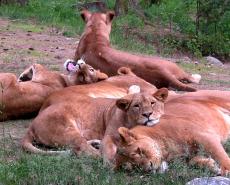Methods
Subjects

Out of the four zoos included in this study, two institutions kept their lions on a high frequency feeding regime (HF) with about 4 to 5 feedings per week. The other two zoos fed their lions on a low frequency feeding regime (LF) with only one feeding per week. Borås Djurpark and Copenhagen Zoo adopted the HF regime; Givskud Zoo and Kolmården Djurpark adopted the LF feeding regime. The LF feeding resulted in several consecutive fasting days (see Table 1).
All lions were born and raised in captivity. Every pride consisted of at least one male and several females. Small cubs were excluded from the study.

Observation

During the pilot study, two ethograms were created. Behaviours, activities and appropriate categories were chosen according to the standardized ethogram for felidae by Stanton et al. (2015)
The behaviour ethogram included 19 behaviours categorized in social, agonistic, marking, exploratory and maintenance behaviours (see Table 2). As some of these behaviours occurred infrequently (such as mounting, roaring or flehmen) all behaviours were recorded whenever they occurred according to behaviour sampling (Altmann 1974).

The activity ethogram included 8 activity states clustered into the four categories inactivity, activity, feeding and pacing (see Table 4). The activity states of every individual were recorded every minute with instantaneous scan sampling (Altmann 1974).
I spent four weeks with each pride, observing 6 days per week. During each session I recorded three hours between 4 pm and 8 pm. This resulted in 72 h of data per pride.
Analysis
Statistical analysis was conducted with SPSS. Comparisons between the four zoos were conducted with the Mann-Whitney-U test. Statistical significance was p = 0.05.
Responsible for this page:
Director of undergraduate studies Biology
Last updated:
05/16/17
